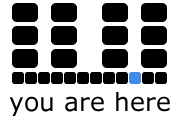Protocol
by Jentery, Curtis, Matthew & Jamie
Standardization is a theme found throughout our writings of “Standards in the Making” (SITM), as part of the new work of composing. Standards are provided through some sense of a protocol, whether written in the actual software of collaborative tagging systems or in the “rules” of cultural formation. Foremost recognizing standards as a practice, each of our writings discuss the ways in which this practice resolves the collective organizing of the Flickr Commons folksonomy. Some sense of protocol therefore intersects our understanding of how this new work of composing proceeds. Matt, in his critique of the Flickr Commons folksonomy, argues that this form of standardization has become “too crystallized, too stabilized, too group-think.” For him, the code at work in the Flickr Commons “captured” the possibility for “multiple readings”, rendering ineffective moves towards discursive formulation. The protocol, at a systemic level, “is designed to immobilize discourse.” For Jamie, metadata schemes designed for “search and retrieval” effectively become “disinterested, noncritical, and arhetorical.” However, Jamie holds that social metadata systems, like folksonomies, move beyond description and function rhetorically. For him, the protocol of the Flickr Commons enables such a “new social discourse space where arguments are mobilized through metadata itself.” It is through these discursive spaces that standards are enabled to emerge.
The enabling work of protocols is further discussed by Jentery and Curtis. Both trace the Flickr Commons folksonomy for ways in which user-generated tags exceed the reading that tags merely describe. Within the Flickr Commons, Jentery notes the reliances that standards provide, in that each photo entry follows a certain protocol to provide information across the archive. Interestingly, these standards were largely folded into the folksonomic system; those more standard standards inevitably leaked into other protocols. Furthermore, Jentery describes how the protocol of the Flickr Commons worked to produce “implicit metadata.” Likewise, Curtis discusses how protocols “are themselves generative constraints that facilitate (as well as restrict) the way that metadata itself operates as a compositional practice.” Here, he notes the rules that explicitly organize the archive — such as “negro” in the Library of Congress and “African-American” in the Smithsonian — which generates a series of struggles to define or counter-define the metadata on an artifact. The protocol functions to produce arguments.
What protocols, with what level of standardization, are necessary for the collective organizing of data, broadly understood? How can a standards-in-the-making approach proceed while recognizing the generative constraints implicit in all standards What processes must be fixed, infrastructurally, institutionally, and socially, as Curtis writes, in order to enable this collective practice? As we have discussed variously, the new work of composing involves such attentiveness to the inevitable protocols that alleviate the stresses of creative and critical collaborations.
